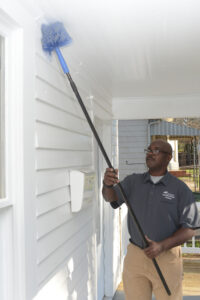The Misunderstood Brown Recluse
Being a bit of an arachnophobe myself, I tend to shudder just a bit when I see or hear the words, ‘brown recluse’. I mean, we’ve all heard the horror stories and seen the awful photos of the supposed brown recluse bites. But the more I’ve studied and researched, the more I’ve learned the truth. Despite the bad reputation given to these little guys, they don’t do nearly the damage attributed to their species. Here’s the lowdown.

First is identification. Should you want to get close enough to identify it, not me thank you very much, there are some identifying markers of the brown recluse spider. It is shocker, brown in color, and has the infamous violin-shaped marking where its legs attach to the cephalothorax. Fully extended, this spider is about the size of a quarter. Many times people think they have found a brown recluse when it is actually a Southern House Spider, which is the most common spider Georgians find in our homes. Lots of spider species are brown because brown is a great camouflage color. Then add the clue word, ‘reclusive’, and understand that the brown recluse isn’t out and about socializing very often. They are, by nature, reclusive. So chances are if you see it, it’s not likely to be a recluse.
So here are some numbers that might be interesting. The University of Georgia receives many specimens of supposed brown recluse from throughout the state each year. In 2007, they had only verified 14 actual brown recluse spiders all year! Also, of the 159 Georgia counties, only 31 have actually had verified brown recluse sightings. Another piece of good news is that these spiders aren’t as aggressive as everyone fears. One family in Kansas found and collected over 2,000 brown recluses over a 6 month period and had lived there more than 8 years without a single bite. On a side note, I would be out of there before you could say ‘there’s another one’!
Here’s the bad news: Cherokee County has had verified brown recluses found in various places. It is true. Also true is that the bite can be really bad, note the word can. A bite will likely heal on its own without any intervention. In rare cases though, there can be trouble from a bite. There is tissue damage that happens through the saliva secretions in the spider venom. Still, the majority of so-called spider bites aren’t spider bites at all. So what is happening?
Knowledgeable scientists and doctors say that many times the presumed spider bites are actually Staphylococcus aureus or MRSA. This infection is resistant to common antibiotics such as penicillin and can result in skin infections, boils, and lesions. Other misdiagnosed health issues that cause a spider bite appearance are diabetes complications, Lyme disease, bed sores, and even necrotizing bacteria. These misdiagnosed patients could be delaying the correct treatment if misdiagnosed as a spider bite. Correct diagnosis is vital.
So the bottom line is this, brown recluses are busy, rare, and reclusive. So while it is definitely possible to have a brown recluse spider in your home and definitely possible that you or someone you know will have a bite, it is not as common as most people think.
In general, spiders are in your home because there is a food source there. Spiders’ diet consists of roaches, ants, and even centipedes. I suppose they are kind of like nature’s pest control. Still, you may be like me and prefer they do their pest control dining outside. Keeping your home free of insects by sealing up any cracks and crevices, having regular pest control services performed by a licensed pest control company, and keeping surfaces clean is the best way to keep spiders out.
If you have insect problems, call us at Canton Termite at 770-479-1598.
By: Robin
